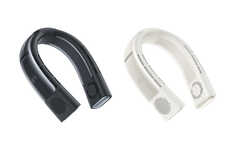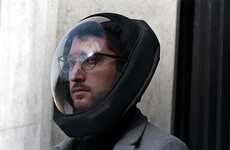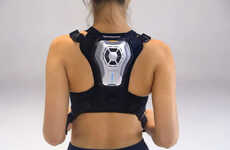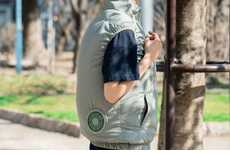
The Tajima Seiryo Offers a Wearable Ventilator Solution for Hot Climates
References: japantrendshop
To help consumers cope in hot climates, the Tajima Seiryo is a wearable cooling helmet fan designed to help prevent heatstroke in balmy weather. The fan is a wearable ventilator that sits on the back of the consumer's head to provide a constant breeze. The idea is that the continual circulation of air helps to cool the wearer's body temperature to eliminate the potential of fainting from the heat.
The helmet consists of two parts with the first being a hardshell hat. The shell provides a fitted aesthetic complete with perforated edges for added ventilation. The helmet connects to a miniature fan that is powered with a lithium-ion battery to offer between eight to 18 hours of continual breeze on the wearer's neck.
The helmet consists of two parts with the first being a hardshell hat. The shell provides a fitted aesthetic complete with perforated edges for added ventilation. The helmet connects to a miniature fan that is powered with a lithium-ion battery to offer between eight to 18 hours of continual breeze on the wearer's neck.
Trend Themes
1. Wearable Cooling Devices - The trend of wearable cooling devices presents disruptive innovation opportunities for creating innovative solutions to help individuals cope with hot climates.
2. Personal Climate Control - The trend of personal climate control opens opportunities for disruptive innovation in creating customizable and portable solutions to regulate body temperature in different environments.
3. Heatstroke Prevention - The trend of heatstroke prevention offers disruptive innovation opportunities for developing advanced technologies and wearable solutions that protect individuals from the dangers of extreme heat.
Industry Implications
1. Outdoor Recreation - The outdoor recreation industry can explore disruptive innovation by incorporating wearable cooling devices into their products to enhance outdoor experiences in hot climates.
2. Healthcare - The healthcare industry can leverage personal climate control technology to improve patient comfort and prevent heat-related illnesses in medical settings or during transportation of patients.
3. Work Safety - The work safety industry can benefit from disruptive innovation in heatstroke prevention by implementing wearable cooling solutions to protect workers in hazardous environments with high temperatures.
6
Score
Popularity
Activity
Freshness























